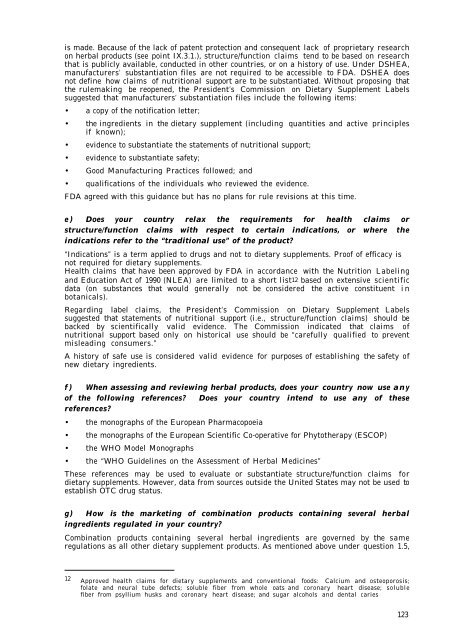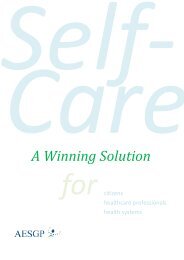Herbal medicinal products in the European Union - AESGP
Herbal medicinal products in the European Union - AESGP
Herbal medicinal products in the European Union - AESGP
You also want an ePaper? Increase the reach of your titles
YUMPU automatically turns print PDFs into web optimized ePapers that Google loves.
is made. Because of <strong>the</strong> lack of patent protection and consequent lack of proprietary research<br />
on herbal <strong>products</strong> (see po<strong>in</strong>t IX.3.1.), structure/function claims tend to be based on research<br />
that is publicly available, conducted <strong>in</strong> o<strong>the</strong>r countries, or on a history of use. Under DSHEA,<br />
manufacturers’ substantiation files are not required to be accessible to FDA. DSHEA does<br />
not def<strong>in</strong>e how claims of nutritional support are to be substantiated. Without propos<strong>in</strong>g that<br />
<strong>the</strong> rulemak<strong>in</strong>g be reopened, <strong>the</strong> President’s Commission on Dietary Supplement Labels<br />
suggested that manufacturers’ substantiation files <strong>in</strong>clude <strong>the</strong> follow<strong>in</strong>g items:<br />
• a copy of <strong>the</strong> notification letter;<br />
• <strong>the</strong> <strong>in</strong>gredients <strong>in</strong> <strong>the</strong> dietary supplement (<strong>in</strong>clud<strong>in</strong>g quantities and active pr<strong>in</strong>ciples<br />
if known);<br />
• evidence to substantiate <strong>the</strong> statements of nutritional support;<br />
• evidence to substantiate safety;<br />
• Good Manufactur<strong>in</strong>g Practices followed; and<br />
• qualifications of <strong>the</strong> <strong>in</strong>dividuals who reviewed <strong>the</strong> evidence.<br />
FDA agreed with this guidance but has no plans for rule revisions at this time.<br />
e ) Does your country relax <strong>the</strong> requirements for health claims or<br />
structure/function claims with respect to certa<strong>in</strong> <strong>in</strong>dications, or where <strong>the</strong><br />
<strong>in</strong>dications refer to <strong>the</strong> “traditional use” of <strong>the</strong> product?<br />
“Indications” is a term applied to drugs and not to dietary supplements. Proof of efficacy is<br />
not required for dietary supplements.<br />
Health claims that have been approved by FDA <strong>in</strong> accordance with <strong>the</strong> Nutrition Label<strong>in</strong>g<br />
and Education Act of 1990 (NLEA) are limited to a short list12 based on extensive scientific<br />
data (on substances that would generally not be considered <strong>the</strong> active constituent i n<br />
botanicals).<br />
Regard<strong>in</strong>g label claims, <strong>the</strong> President’s Commission on Dietary Supplement Labels<br />
suggested that statements of nutritional support (i.e., structure/function claims) should be<br />
backed by scientifically valid evidence. The Commission <strong>in</strong>dicated that claims of<br />
nutritional support based only on historical use should be “carefully qualified to prevent<br />
mislead<strong>in</strong>g consumers.”<br />
A history of safe use is considered valid evidence for purposes of establish<strong>in</strong>g <strong>the</strong> safety of<br />
new dietary <strong>in</strong>gredients.<br />
f ) When assess<strong>in</strong>g and review<strong>in</strong>g herbal <strong>products</strong>, does your country now use any<br />
of <strong>the</strong> follow<strong>in</strong>g references? Does your country <strong>in</strong>tend to use any of <strong>the</strong>se<br />
references?<br />
• <strong>the</strong> monographs of <strong>the</strong> <strong>European</strong> Pharmacopoeia<br />
• <strong>the</strong> monographs of <strong>the</strong> <strong>European</strong> Scientific Co-operative for Phyto<strong>the</strong>rapy (ESCOP)<br />
• <strong>the</strong> WHO Model Monographs<br />
• <strong>the</strong> “WHO Guidel<strong>in</strong>es on <strong>the</strong> Assessment of <strong>Herbal</strong> Medic<strong>in</strong>es”<br />
These references may be used to evaluate or substantiate structure/function claims for<br />
dietary supplements. However, data from sources outside <strong>the</strong> United States may not be used to<br />
establish OTC drug status.<br />
g) How is <strong>the</strong> market<strong>in</strong>g of comb<strong>in</strong>ation <strong>products</strong> conta<strong>in</strong><strong>in</strong>g several herbal<br />
<strong>in</strong>gredients regulated <strong>in</strong> your country?<br />
Comb<strong>in</strong>ation <strong>products</strong> conta<strong>in</strong><strong>in</strong>g several herbal <strong>in</strong>gredients are governed by <strong>the</strong> same<br />
regulations as all o<strong>the</strong>r dietary supplement <strong>products</strong>. As mentioned above under question 1.5,<br />
12 Approved health claims for dietary supplements and conventional foods: Calcium and osteoporosis;<br />
folate and neural tube defects; soluble fiber from whole oats and coronary heart disease; soluble<br />
fiber from psyllium husks and coronary heart disease; and sugar alcohols and dental caries<br />
123




